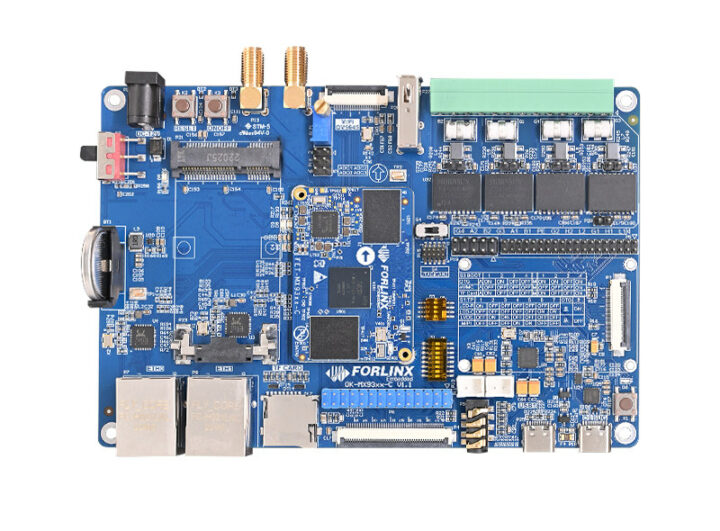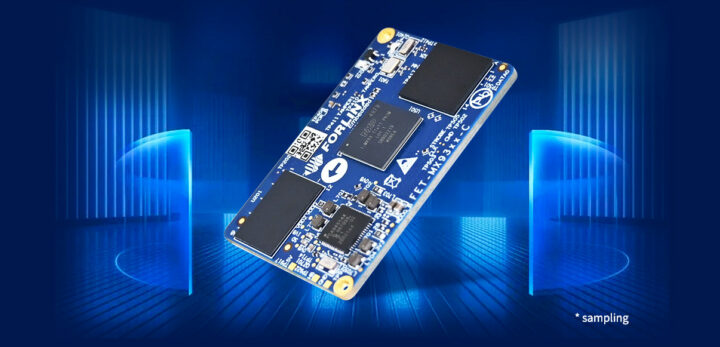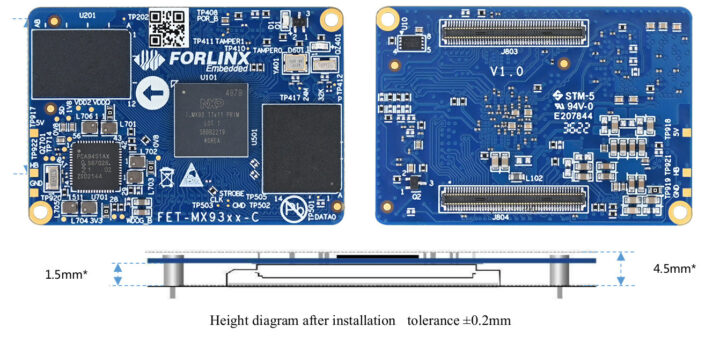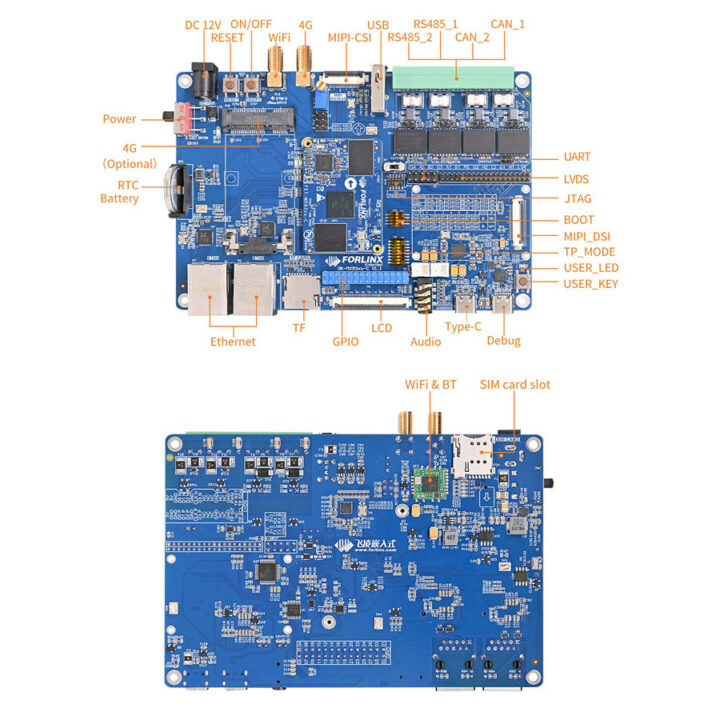Forlinx FET-MX9352-C is a system-on-module based on NXP i.MX 9352 dual Cortex-A55 processor with Cortex-M33 real-time core and a 0.5 TOPS AI accelerator that can be used for industrial control, IoT gateways, medical equipment, and various applications requiring machine learning acceleration.
The FET-MX9352-C follows last week’s announcement of the iWave Systems iW-RainboW-G50M OSM module and SBC with a choice of NXP i.MX 93 processors. The Forlinx module comes with two board-to-board connectors instead of solderable pads and can be found in the OK-MX9352-C single board computer with dual GbE, various display and camera interfaces, RS485 and CAN Bus, etc…
FET-MX9352-C i.MX 9352 system-on-module
Specifications:
- SoC – NXP i.MX 9352 with 2x Arm Cortex-A55 cores @ up to 1.7GHz (commercial) or 1.5 GHz (industrial), Cortex-M33 real-time core @ 250 MHz, 0.5 TOPS Arm Ethos U65 microNPU
- System Memory – 1GB/2GB LPDDR4 RAM
- Storage – 8GB eMMC flash
- 2x high-density 100-pin board-to-board connectors with:
- Display I/F
- LVDS up to 1366×768 @ 60Hz or 1280×800 @ 60Hz
- RGB parallel up to 1366×768 @ 70Hz or 1280×800 @ 60Hz
- MIPI DSI up to 1920×1200 @ 60Hz
- Camera I/F – 2-lane MIPI CSI-2 camera input
- Audio
- 3x SAI interfaces with support for I2S, AC97, TDM formats
- 1x SPDIF
- 1x 24-bit PDM for microphone
- Networking – 2x Gigabit Ethernet (one TSN capable)
- USB – 2x USB 2.0
- SDIO – 2x 4-bit SD/SDIO interface
- Serial – 8x UART up to 5 Mbps, 2x CAN-FD / CAN 2.0B
- Debugging – JTAG for Cortex-M33
- Other peripheral interfaces
- 8x SPI, 8x I2C
- 2x MIPI I3C up to 12.5 MHz
- 4x 12-bit ADC up to 1MS/s
- Display I/F
- Supply Voltage – 5V
- Dimensions – 48 x 33 mm (thickness: 4.5mm after installation)
- Temperature Range – Industrial: -40°C ~ 85°C (sampling); commercial: 0 to 70°C (planned)
Forlinx provides a Linux SDK based on Linux 5.15.52 and Qt 6.3.2. It’s only available to customers (i.e. not accessible publicly) and is said to include a user manual, build instructions, the kernel source code, a root file system, an OS image, a VM Ubuntu image, an SD card tool, a USB OTG tool, and Qt demos with source code. Hardware documentation is comprised of a datasheet, the schematics and PCB layout for the carrier board, a pinmux sheet, as well as the DXF files for the SOM and carrier board.
OK-MX9352-C single board computer
 While on the topic of the carrier board, here are Forlinx OK-MX9352-C specifications:
While on the topic of the carrier board, here are Forlinx OK-MX9352-C specifications:
- Supported SoM – Folinx FET-MX9352-C described above
- Storage – MicroSD card slot for OS image flashing
- Display
- 24-bit RGB interface
- 8-bit LVDS interface
- 4-lane MIPI DSI
- Camera – MIPI CSI connector tested with OV5645 module
- Audio – 3.5mm audio jack with headphones and microphone signals
- Networking
- 2x Gigabit Ethernet RJ45 ports (ETH1 supports TSN)
- On-board BL-M8723DU module with 2.4GHz WiFi, Bluetooth 4.2/2.1, SMA antenna connector
- Optional support for 4G LTE via EC20 mini PCIe module, SIM card slot, and SMA antenna connector
- USB – 1x USB Type-A port, 1x USB Type-C port for flashing OS
- Expansion
- 28-pin GPIO header with 9x GPIOs, 12-bit ADC, etc…; multiplexed with LCD
- 10-pin header with 2x UART
- Terminal block with 2x CAN-FD, 2x RS-485
- Debugging – 10-pin JTAG header, USB Type-C connector for serial console
- Misc –
- RTC + battery holder
- Reset, power on/off, and user key
- Power switch
- 1x user LED
- Power Supply – 12V DC via power barrel jack
- Dimensions – TBD
The industrial-grade version of the FET-MX9352-C is currently sampling, and Forlinx told CNX Software customers can already order samples and the development kit. The commercial version with i.MX 9352 processor and an industrial-grade SoM with i.MX 9331 single core Cortex-A55 processor are scheduled and should become available lateron. The NXP i.MX 93 processors will officially be launched in 2023 and stay available for at least 15 years, or until 2038. But if the i.MX 93 family gets the same treatment as the i.MX 6 family with its life cycle extended until 2036, or a 25 years life cycle, the i.MX 93 might eventually end up being sold until 2048!
Additional information may be found on the product pages for the module and devkit.

Jean-Luc started CNX Software in 2010 as a part-time endeavor, before quitting his job as a software engineering manager, and starting to write daily news, and reviews full time later in 2011.
Support CNX Software! Donate via cryptocurrencies, become a Patron on Patreon, or purchase goods on Amazon or Aliexpress







